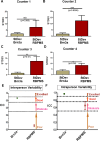Comparison of Brn3a and RBPMS Labeling to Assess Retinal Ganglion Cell Loss During Aging and in a Model of Optic Neuropathy
- PMID: 38587440
- PMCID: PMC11005068
- DOI: 10.1167/iovs.65.4.19
Comparison of Brn3a and RBPMS Labeling to Assess Retinal Ganglion Cell Loss During Aging and in a Model of Optic Neuropathy
Abstract
Purpose: Retinal ganglion cell (RGC) loss provides the basis for diagnosis and stage determination of many optic neuropathies, and quantification of RGC survival is a critical outcome measure in models of optic neuropathy. This study examines the accuracy of manual RGC counting using two selective markers, Brn3a and RBPMS.
Methods: Retinal flat mounts from 1- to 18-month-old C57BL/6 mice, and from mice after microbead (MB)-induced intraocular pressure (IOP) elevation, are immunostained with Brn3a and/or RBPMS antibodies. Four individuals masked to the experimental conditions manually counted labeled RGCs in three copies of five images, and inter- and intra-person reliability was evaluated by the intraclass correlation coefficient (ICC).
Results: A larger population (approximately 10% higher) of RGCs are labeled with RBPMS than Brn3a antibody up to 6 months of age, but differences decrease to approximately 1% at older ages. Both RGC-labeled populations significantly decrease with age. MB-induced IOP elevation is associated with a significant decrease of both Brn3a- and RBPMS-positive RGCs. Notably, RGC labeling with Brn3a provides more consistent cell counts than RBPMS in interpersonal (ICC = 0.87 to 0.11, respectively) and intra-personal reliability (ICC = 0.97 to 0.66, respectively).
Conclusions: Brn3a and RBPMS markers are independently capable of detecting significant decreases of RGC number with age and in response to IOP elevation despite RPBMS detecting a larger number of RGCs up to 6 months of age. Brn3a labeling is less prone to manual cell counting variability than RBPMS labeling. Overall, either marker can be used as a single marker to detect significant changes in RGC survival, each offering distinct advantages.
Conflict of interest statement
Disclosure:
Figures





Similar articles
-
Optimizing retinal ganglion cell nuclear staining for automated cell counting.Exp Eye Res. 2024 May;242:109881. doi: 10.1016/j.exer.2024.109881. Epub 2024 Mar 28. Exp Eye Res. 2024. PMID: 38554800 Free PMC article.
-
Quantitative analysis of retinal ganglion cell survival with Rbpms immunolabeling in animal models of optic neuropathies.Invest Ophthalmol Vis Sci. 2011 Dec 28;52(13):9694-702. doi: 10.1167/iovs.11-7869. Invest Ophthalmol Vis Sci. 2011. PMID: 22110060 Free PMC article.
-
Software for Quantifying and Batch Processing Images of Brn3a and RBPMS Immunolabelled Retinal Ganglion Cells in Retinal Wholemounts.Transl Vis Sci Technol. 2020 May 27;9(6):28. doi: 10.1167/tvst.9.6.28. eCollection 2020 May. Transl Vis Sci Technol. 2020. PMID: 32821525 Free PMC article.
-
Pan-retinal ganglion cell markers in mice, rats, and rhesus macaques.Zool Res. 2023 Jan 18;44(1):226-248. doi: 10.24272/j.issn.2095-8137.2022.308. Zool Res. 2023. PMID: 36594396 Free PMC article. Review.
-
Assessment of retinal ganglion cell damage in glaucomatous optic neuropathy: Axon transport, injury and soma loss.Exp Eye Res. 2015 Dec;141:111-24. doi: 10.1016/j.exer.2015.06.006. Epub 2015 Jun 9. Exp Eye Res. 2015. PMID: 26070986 Review.
Cited by
-
A Simple and Rapid Method for Simultaneous Isolation of Mouse Retina and RPE Wholemounts.Transl Vis Sci Technol. 2025 May 1;14(5):14. doi: 10.1167/tvst.14.5.14. Transl Vis Sci Technol. 2025. PMID: 40354066 Free PMC article.
-
The role of neurotrophic factors in retinal ganglion cell resiliency.Front Cell Neurosci. 2025 Jan 29;19:1536452. doi: 10.3389/fncel.2025.1536452. eCollection 2025. Front Cell Neurosci. 2025. PMID: 39944766 Free PMC article. Review.
-
The Effect of Advancing Age and Intraocular Pressure Injury on Retinal Ganglion Cell Function and Synaptic Connectivity.Aging Cell. 2025 Jun;24(6):e70005. doi: 10.1111/acel.70005. Epub 2025 Feb 27. Aging Cell. 2025. PMID: 40016944 Free PMC article.
-
Optic Nerve Crush Does Not Induce Retinal Ganglion Cell Loss in the Contralateral Eye.Invest Ophthalmol Vis Sci. 2025 Mar 3;66(3):49. doi: 10.1167/iovs.66.3.49. Invest Ophthalmol Vis Sci. 2025. PMID: 40126507 Free PMC article.
References
-
- Newman NJ, Yu-Wai-Man P, Biousse V, Carelli V.. Understanding the molecular basis and pathogenesis of hereditary optic neuropathies: towards improved diagnosis and management. Lancet Neurol. 2023; 22: 172–188. - PubMed
-
- Chapelle AC, Rakic JM, Plant GT.. The occurrence of intraretinal and subretinal fluid in anterior ischemic optic neuropathy: pathogenesis, prognosis, and treatment. Ophthalmology. 2023; 130: 1191–1200. - PubMed
MeSH terms
Substances
Grants and funding
LinkOut - more resources
Full Text Sources
Medical
Molecular Biology Databases
Miscellaneous

